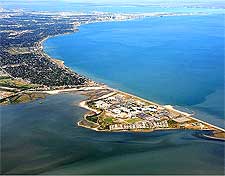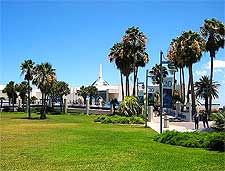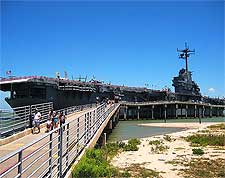Corpus Christi History Facts and Timeline
(Corpus Christi, Texas - TX, USA)

Almost 500 years ago on Corpus Christi, the Roman Catholic festival day honoring the Body of Christ, Alonso Alvarez de Pineda arrived at a spectacular bay on the southern coastline of America. The Spanish explorer named the bay after the religious festival and the city of Corpus Christi was born, although the area wasn't formally settled until 1839.
Early Days
Corpus Christi's first incarnation in 1839 was as a small trading post, established by pioneer leader and adventurer Colonel Henry Lawrence Kinney. It remained remote until the run-up to the Mexican-American War (1846 to 1848). Troops led by General Zachary Taylor arrived and set up camp in 1845, and subsequently marched south to enforce the Rio Grande River as the southernmost US border a year later.
The military camp's year in the area drew suppliers and craftsmen to the settlement and, in 1846, the developing town was officially named Corpus Christi and held mayoral and city council elections. Law and order became the norm in early Corpus Christi history, with an 1879 ordinance aimed at cleaning up the town, including fines for 'allowing pigs and goats to run loose in the streets'.

Impediments to Growth
Notwithstanding its position on Corpus Christi Bay, the little town's port was shallow, impeding its growth as a transportation hub for 70 years or so. Supply and trading ships were forced to anchor far out in the bay and transfer their goods to shallow-draft boats. Although successive city fathers continued advertising the town by any means possible throughout this period in history, including in European newspapers, the wagon trains came, restocked and mostly left as they had arrived.
Civil War
Gradually the population, set at 1,200 in 1860, increased, although, in true frontier town style, men vastly outnumbered women. By the time the Civil War broke out in 1861, one-third of the city's residents were foreign-born. Confederate Corpus Christi was an important commercial crossroads during the conflict, in spite of a Union blockade, with small boats shipping necessities between the two rivers, the Bravos and Rio Grande, and wagons transporting goods to and from
Mexico.
Recovery and Prosperity in Corpus Christi
Corpus Christi was bombarded twice during the Civil War in an attempt to stop trade, and was finally occupied by Union forces in 1863. The end of the war put an end to the city's occupation, with swift economic recovery aided by a market for wool and the growth of ranching in the region.
In the late 19th century, Corpus Christi history saw a cattle boom and this ensured massive growth, with the city becoming a major shipping destination for cattle drives from the southern plains, especially after the dredging of the port to allow steamers to dock. By 1885, two railroads served the town, which before the end of the century had mostly paved roads, a municipal water system and a population of around 4,200.

The 20th Century and Onwards
In the early years of the 20th century, rapid development continued, with the city promoted by the railroads as a tourist destination. Its waterside delights and entertainment were touted with cheap rail fares as an incentive. The 1919 Hurricane set plans back, but it also sparked the development of a large, deep-water port. Ten years after the port was opened, Corpus Christi's population doubled, new industries moved in and many impressive buildings were constructed.
Although growth slowed during the Great Depression, the 1930 discovery of oil in Texas set the seal on the city's prosperity. Nowadays, it's a hub for the petrochemical industry and attracts visitors for its recreational facilities, historic buildings, state parks and wildlife sanctuaries, as well as its arts and entertainment venues.
 Almost 500 years ago on Corpus Christi, the Roman Catholic festival day honoring the Body of Christ, Alonso Alvarez de Pineda arrived at a spectacular bay on the southern coastline of America. The Spanish explorer named the bay after the religious festival and the city of Corpus Christi was born, although the area wasn't formally settled until 1839.
Almost 500 years ago on Corpus Christi, the Roman Catholic festival day honoring the Body of Christ, Alonso Alvarez de Pineda arrived at a spectacular bay on the southern coastline of America. The Spanish explorer named the bay after the religious festival and the city of Corpus Christi was born, although the area wasn't formally settled until 1839.
